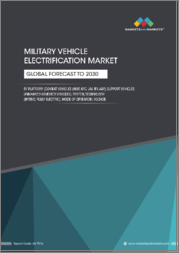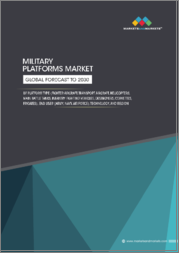
|
시장보고서
상품코드
1705127
군용 차량 시장 평가 : 플랫폼, 모빌리티, 유형, 지역별 기회 및 예측(2018-2032년)Military Vehicle Market Assessment, By Platform, By Mobility, By Type, Region, Opportunities and Forecast, 2018-2032F |
||||||
군용 차량 시장 규모는 국방 지출의 증가, 기술의 진보, 차량 현대화의 필요성 등의 요인에 의해 2024년 236억 4,000만 달러에서 예측 기간 중 CAGR 6.14%로 추이하며, 2032년에는 380억 7,000만 달러로 성장할 것으로 예측됩니다. 주요 동향으로는 전기 및 하이브리드 추진 시스템의 도입, 무인화 및 자율화 기능의 통합, 모듈식 및 다목적 플랫폼의 개발 등이 있으며, 이는 예측 기간 중 시장 성장을 더욱 촉진할 것으로 보입니다. 또한 첨단 장갑 및 능동적 보호 시스템을 통한 생존성 향상에 대한 관심도 증가하고 있습니다. 이러한 추세는 전 세계 군가 현재와 미래의 안보 과제를 해결할 수 있는 다기능, 효율적이고 내구성이 뛰어난 차량을 갖추기 위한 노력을 반영하고 있습니다.
세계의 군용 차량 시장을 조사했으며, 시장의 정의와 개요, 시장 규모 추이·예측, 각종 구분별 상세 분석, 산업 구조, 시장 성장에 대한 영향요인의 분석, 사례 연구, 경쟁 구도, 주요 기업의 개요 등을 정리하여 전해드립니다.
목차
제1장 프로젝트 범위와 정의
제2장 조사 방법
제3장 개요
제4장 고객의 소리
- 브랜드 인지도
- 기술적 우위성
- 강화된 보호와 생존성
- 구입 결정시 고려되는 요소
제5장 세계의 군용 차량 시장 전망
- 시장 규모 분석·예측
- 시장 점유율 분석·예측
- 플랫폼별
- 모빌리티별
- 유형별
- 지역별
- 기업 점유율 분석(상위 5사 및 기타)
- 시장 맵 분석
제6장 북미의 군용 차량 시장 전망
- 시장 규모 분석·예측
- 시장 점유율 분석·예측
- 국가별 시장 평가
- 미국
- 캐나다
- 멕시코
제7장 유럽의 군용 차량 시장 전망
- 독일
- 프랑스
- 영국
- 러시아
- 튀르키예
- 기타
제8장 아시아태평양의 군용 차량 시장 전망
- 인도
- 중국
- 일본
- 호주
- 기타
제9장 기타 지역의 군용 차량 시장 전망
- 남미
- 중동 및 아프리카
제10장 수급 분석
제11장 수출입 분석
제12장 밸류체인 분석
제13장 Porter's Five Forces 분석
제14장 PESTLE 분석
제15장 시장 역학
- 시장 성장 촉진요인
- 시장이 해결해야 할 과제
제16장 시장 동향·배포
제17장 정책과 규제 상황
제18장 사례 연구
제19장 경쟁 구도
- 상위 5사의 경쟁 매트릭스
- 상위 5사의 SWOT 분석
- 상위 10사의 상황
- General Dynamics Corporation
- BAE Systems plc
- Rheinmetall AG
- Lockheed Martin Corporation
- Oshkosh Corporation
- Northrop Grumman
- Elbit Systems Ltd.
- Hanwha Corporation
- Mitsubishi Heavy Industries, Ltd.
- Textron Systems Corporation
제20장 전략적 제안
제21장 Market Xcel - Markets and Data 소개·면책사항
KSA 25.05.02Military vehicle market is projected to witness a CAGR of 6.14% during the forecast period 2025-2032, growing from USD 23.64 billion in 2024 to USD 38.07 billion in 2032F, owing to factors such as increased defense spending, technological advancements, and the need for fleet modernization. Key trends comprise the adoption of electric and hybrid propulsion systems, the integration of unmanned and autonomous capabilities, and the development of modular and multi-role platforms, which further drive global market growth in the forecast period. Additionally, there is a heightened focus on enhancing survivability through advanced armor and active protection systems. These trends reflect a concerted effort by military forces worldwide to equip themselves with versatile, efficient, and resilient vehicles capable of addressing contemporary and future security challenges.
In March 2025, an all-terrain stealth vehicle, Veer, developed by Bengaluru-based electric vehicle startup Pravaig Dynamics Private Limited, completed military trials and was honored with the esteemed iDEX award from the Ministry of Defence. The VEER Electric Tactical All-Terrain Vehicle (E-TATV) represents a state-of-the-art, highly discreet vehicle tailored for forward patrolling, reconnaissance, and intelligence, surveillance, and reconnaissance (ISR) missions.
Military Modernization to Fuel the Military Vehicle Market
Military forces globally are actively modernizing their vehicle fleets to cater to the evolving security challenges and technological advancements. This includes upgrading existing platforms and procuring new vehicles equipped with advanced capabilities. Increased defense budgets, driven by geopolitical tensions and the need for enhanced operational readiness, are facilitating these modernization efforts. For instance, countries are investing in next-generation armored vehicles and combat systems to maintain strategic superiority. Superpowers are also adding new layers to their combat fleet with the launch of new-generation combat vehicles.
For instance, in November 2024, the United States Army launched fifth-generation combat vehicles through its M1E3 Abrams tank modernization program. The M1E3 Abrams main battle tank is set to become the United States Army's inaugural hybrid-electric combat vehicle. This prototype highlights several advanced features, including a hybrid-electric diesel engine, a lighter design, an unmanned turret, and systems powered by artificial intelligence.
The incorporation of such cutting-edge technologies is transforming military vehicles into more effective and versatile assets. Key features include the adoption of electric and hybrid propulsion systems for improved fuel efficiency and reduced logistical burdens. Additionally, the integration of unmanned systems, modular armor, and sophisticated communication tools enhances situational awareness and battlefield effectiveness. These technological innovations are pivotal in developing vehicles that can operate seamlessly in complex combat environments.
Multi-Role Vehicles to Shape the Global Military Vehicle Market
There is a growing trend towards designing military vehicles with multi-role capabilities and modular configurations. This approach allows for rapid adaptation to various mission requirements, from direct combat to reconnaissance and logistics support. Modular designs enable the customization of vehicles with different weapon systems, armor levels, and communication suites, providing armed forces with flexible and cost-effective solutions to meet diverse operational requirements.
For instance, in February 2025, Tata Advanced Systems Limited (TASL) showcased its Made in India Nato-compliant armored vehicle for the global market. The company introduced a domestically designed Light Armoured Multi-role Vehicle (LAMV) that meets NATO standards for the armed forces during the current IDEX 2025 event in Abu Dhabi.
Enhancing the survivability of military personnel plays a critical role in vehicle development. This involves incorporating advanced armor materials, active protection systems, and countermeasure technologies to defend against emerging threats such as improvised explosive devices (IEDs) and anti-tank guided missiles.
Wheeled Segment Leads with Higher Flexibility and Maneuverability
The wheeled segment leads the global military vehicle market due to its flexibility and maneuverability, making it ideal for diverse operational scenarios. These vehicles excel in urban environments and paved roads, offering superior mobility compared to their tracked counterparts. Their lightweight design enhances speed and agility, allowing rapid deployment in special operations, troop transport, border patrols, and combat support missions such as reconnaissance and medical aid.
Additionally, wheeled military vehicles are cost-effective in terms of acquisition, maintenance, and fuel efficiency, making them more practical for sustained use. Their modular configurations enable customization for specific mission requirements, further boosting their utility. For instance, in October 2024, GM Defense (General Motors Company) launched a "Next Gen" tactical vehicle prototype at the Association of the United States Army (AUSA) 2024. The tough and resilient Next Gen truck, which is based on the Chevrolet Silverado 3500HD ZR2 truck, has a 2.8L Duramax turbo-diesel engine from GM, a 12-module battery pack, and drive motors for the front and rear axles that enable Silent Drive and Silent Watch.
North America Dominates the Military Vehicle Market
North America dominates the global military vehicle market due to its substantial defense spending and active participation of private defense companies. The region prioritizes modernizing its military fleets and integrating advanced technologies into armored vehicles, such as enhanced protection systems and network-based combat capabilities. Major defense contractors drive innovation through investments in next-generation designs, including robotic and unmanned platforms. Geopolitical tensions and government support further sustain demand for cutting-edge military vehicles, solidifying North America's leadership in both procurement and technological advancements within this sector.
For instance, in April 2024, the United States Army formally christened the M10 Booker during a ceremony at Aberdeen Proving Ground, officially introducing the service's newest combat vehicle. This event highlighted the platform's importance in modernizing light maneuver forces and providing them with a decisive battlefield advantage. Furthermore, the army granted GDLS a contract valued at around USD 1.14 billion for the manufacturing and delivery of the M10 Booker as part of the Mobile Protected Firepower (MPF) initiative. This agreement includes plans to produce a total of 504 vehicles, with production set to increase following the successful conclusion of Low-Rate Initial Production (LRIP).
Future Market Scenario (2025 - 2032F)
The shift towards electric and hybrid propulsion systems is expected to continue, driven by the need for improved fuel efficiency, reduced logistical footprints, and environmental considerations.
The deployment of unmanned ground vehicles (UGVs) and autonomous systems is likely to expand, enhancing operational capabilities while reducing risks to personnel.
Military vehicles are anticipated to increasingly be equipped with advanced communication and data-sharing technologies, facilitating seamless integration into network-centric warfare environments.
Ongoing developments in armor materials and active protection systems are projected to focus on countering emerging threats, ensuring higher levels of crew and vehicle survivability.
Key Players Landscape and Outlook
Key players in the military vehicle market are focusing on innovation, strategic partnerships, and global expansion to maintain competitiveness. They prioritize the integration of advanced technologies such as artificial intelligence, autonomous driving systems, and electric propulsion to enhance operational efficiency and sustainability. Modular designs are emphasized to allow quick reconfiguration for diverse missions, while investments in lightweight materials improve mobility and protection. Collaborations with defense organizations and governments help secure long-term contracts and align with modernization programs. Additionally, manufacturers are targeting emerging markets with tailored solutions to address regional security needs, leveraging geopolitical tensions to drive demand.
For instance, in February 2025, Lockheed Martin Corporation unveiled the Common Multi-Mission Truck (CMMT), a subsonic, long-range cruise missile engineered for affordability, versatility, and scalability, making it a viable candidate for potential engagements with China. The Common Multi-Mission Truck (CMMT) is a component of Lockheed Martin's Skunk Works division, associated with Project Carrera. This initiative aims to create a versatile autonomy framework that facilitates the integration of both crewed and uncrewed aircraft in cooperative missions.
Table of Contents
1. Project Scope and Definitions
2. Research Methodology
3. Executive Summary
4. Voice of Customers
- 4.1. Brand Awareness
- 4.2. Technological Superiority
- 4.3. Enhanced Protection & Survivability
- 4.4. Factors Considered in Purchase Decisions
- 4.4.1. Adaptability & Modular Design
- 4.4.2. Sustainability Considerations
- 4.4.3. Cost-Effectiveness
5. Global Military Vehicle Market Outlook, 2018-2032F
- 5.1. Market Size Analysis & Forecast
- 5.1.1. By Value
- 5.2. Market Share Analysis & Forecast
- 5.2.1. By Platform
- 5.2.1.1. Armored Fighting Vehicles
- 5.2.1.2. Tactical Trucks
- 5.2.1.3. Unmanned Ground Vehicles
- 5.2.1.4. Self-Propelled Artillery
- 5.2.1.5. Combat Support Vehicles
- 5.2.2. By Mobility
- 5.2.2.1. Wheeled
- 5.2.2.2. Tracked
- 5.2.3. By Type
- 5.2.3.1. Electric Military Vehicles
- 5.2.3.2. Conventional Military Vehicles
- 5.2.4. By Region
- 5.2.4.1. North America
- 5.2.4.2. Europe
- 5.2.4.3. Asia-Pacific
- 5.2.4.4. Rest of the World
- 5.2.5. By Company Market Share Analysis (Top 5 Companies and Others - By Value, 2024)
- 5.2.1. By Platform
- 5.3. Market Map Analysis, 2024
- 5.3.1. By Platform
- 5.3.2. By Mobility
- 5.3.3. By Type
- 5.3.4. By Region
6. North America Military Vehicle Market Outlook, 2018-2032F
- 6.1. Market Size Analysis & Forecast
- 6.1.1. By Value
- 6.2. Market Share Analysis & Forecast
- 6.2.1. By Platform
- 6.2.1.1. Armored Fighting Vehicles
- 6.2.1.2. Tactical Trucks
- 6.2.1.3. Unmanned Ground Vehicles
- 6.2.1.4. Self-Propelled Artillery
- 6.2.1.5. Combat Support Vehicles
- 6.2.2. By Mobility
- 6.2.2.1. Wheeled
- 6.2.2.2. Tracked
- 6.2.3. By Type
- 6.2.3.1. Electric Military Vehicles
- 6.2.3.2. Conventional Military Vehicles
- 6.2.4. By Country Share
- 6.2.4.1. United States
- 6.2.4.2. Canada
- 6.2.4.3. Mexico
- 6.2.1. By Platform
- 6.3. Country Market Assessment
- 6.3.1. United States Military Vehicle Market Outlook, 2018-2032F*
- 6.3.1.1. Market Size Analysis & Forecast
- 6.3.1.1.1. By Value
- 6.3.1.2. Market Share Analysis & Forecast
- 6.3.1.2.1. By Platform
- 6.3.1.2.1.1. Armored Fighting Vehicles
- 6.3.1.2.1.2. Tactical Trucks
- 6.3.1.2.1.3. Unmanned Ground Vehicles
- 6.3.1.2.1.4. Self-Propelled Artillery
- 6.3.1.2.1.5. Combat Support Vehicles
- 6.3.1.2.2. By Mobility
- 6.3.1.2.2.1. Wheeled
- 6.3.1.2.2.2. Tracked
- 6.3.1.2.3. By Type
- 6.3.1.2.3.1. Electric Military Vehicles
- 6.3.1.2.3.2. Conventional Military Vehicles
- 6.3.1.2.1. By Platform
- 6.3.1.1. Market Size Analysis & Forecast
- 6.3.2. Canada
- 6.3.3. Mexico
- 6.3.1. United States Military Vehicle Market Outlook, 2018-2032F*
All segments will be provided for all regions and countries covered
7. Europe Military Vehicle Market Outlook, 2018-2032F
- 7.1. Germany
- 7.2. France
- 7.3. United Kingdom
- 7.4. Russia
- 7.5. Turkey
- 7.6. Rest of Europe
8. Asia-Pacific Military Vehicle Market Outlook, 2018-2032F
- 8.1. India
- 8.2. China
- 8.3. Japan
- 8.4. Australia
- 8.5. Rest of Asia-Pacific
9. Rest of the World Military Vehicle Market Outlook, 2018-2032F
- 9.1. South America
- 9.2. Middle East and Africa
10. Demand Supply Analysis
11. Import and Export Analysis
12. Value Chain Analysis
13. Porter's Five Forces Analysis
14. PESTLE Analysis
15. Market Dynamics
- 15.1. Market Drivers
- 15.2. Market Challenges
16. Market Trends and Developments
17. Policy and Regulatory Landscape
18. Case Studies
19. Competitive Landscape
- 19.1. Competition Matrix of Top 5 Market Leaders
- 19.2. SWOT Analysis for Top 5 Players
- 19.3. Key Players Landscape for Top 10 Market Players
- 19.3.1. General Dynamics Corporation
- 19.3.1.1. Company Details
- 19.3.1.2. Key Management Personnel
- 19.3.1.3. Products and Services
- 19.3.1.4. Financials (As Reported)
- 19.3.1.5. Key Market Focus and Geographical Presence
- 19.3.1.6. Recent Developments/Collaborations/Partnerships/Mergers and Acquisition
- 19.3.2. BAE Systems plc
- 19.3.3. Rheinmetall AG
- 19.3.4. Lockheed Martin Corporation
- 19.3.5. Oshkosh Corporation
- 19.3.6. Northrop Grumman
- 19.3.7. Elbit Systems Ltd.
- 19.3.8. Hanwha Corporation
- 19.3.9. Mitsubishi Heavy Industries, Ltd.
- 19.3.10. Textron Systems Corporation
- 19.3.1. General Dynamics Corporation
Companies mentioned above DO NOT hold any order as per market share and can be changed as per information available during research work.


















